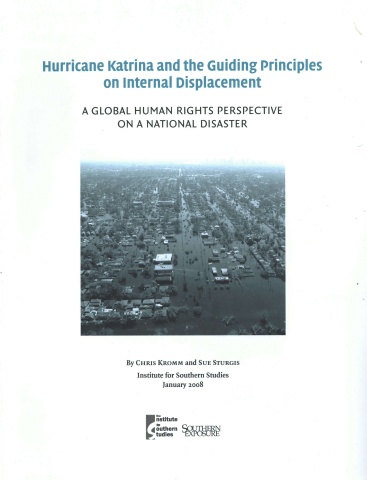Hurricane Katrina and Displacement

This article originally appeared in Southern Exposure Vol. 36 No. 1/2, "Hurricane Katrina and the Guiding Principles on Internal Displacement." Find more from the report here.
The 2005 hurricane season was one of the costliest and most deadly in United States history, wreaking havoc across the U.S. Gulf Coast. The Federal Emergency Management Administration (FEMA) declared 90,000 square miles of the Gulf Coast to be directly impacted by Hurricane Katrina alone38—an area almost as large as the United Kingdom. By September 2005, FEMA had declared 117 counties in Alabama, Louisiana, Mississippi and Texas to be eligible for disaster assistance in the aftermath of Hurricanes Katrina and Rita.39
The number of those immediately displaced by Hurricanes Katrina and Rita is estimated at 1.3 million people,40 placing the 2005 storms on par with the 1.5 million internally displaced persons in the tsunami-affected countries of Asia one year after that disaster.41
The greatest number of internally displaced persons came from southern Louisiana. One study of 18 parishes in and near New Orleans found that the storms forced 398,000 to move away and 151,000 to relocate within their parish.42 One year after Katrina, two-thirds of those displaced from New Orleans were still living out of state or outside the 18-parish area.43
Displacement from the Gulf Coast has had a startling impact on the demographics of the region, especially in the metropolitan areas of New Orleans and Gulfport-Biloxi-Pascagoula, Mississippi. Four months after the storms, the population count of the seven parishes of the New Orleans metro area was 378,000 lower than pre-Katrina levels. The metro area spanning Jackson, Hancock and Harris counties in Mississippi experienced the second-greatest population decrease after the storm, with 50,000 fewer residents.44
Internally displaced persons from Hurricanes Katrina and Rita ended up in all 50 states of the country but were concentrated in Gulf Coast states. As of May 2006, 62 percent of those displaced by the storms were in Louisiana and Mississippi, with Louisiana hosting nearly 42 percent of the internally displaced population and 20 percent still in Mississippi.45
One barrier to accurately assessing the scope and needs of internally displaced persons in the wake of Hurricane Katrina is the lack of monitoring and data by federal agencies. No federal agency is responsible for collecting solid information about the number and location of internally displaced persons, and state-level data varies widely in scope and quality.
Estimates of those still internally displaced several months after the storm range from 450,000 to 650,000.46 A 2006 survey found that 60 percent of those displaced from Louisiana are now based in Texas, Mississippi and Georgia, with another 25 percent displaced in Florida, Alabama, Tennessee, California, North Carolina, Illinois, Arkansas and Virginia.47 Nearly 80 percent of those displaced out of Louisiana came from Orleans or Jefferson Parish.48 As of June 2007, the population of Orleans Parish, Louisiana was two-thirds of its pre-Katrina levels.49
While many internally displaced persons have chosen voluntarily to settle elsewhere, many others say they would like to return to the Gulf Coast. A recent survey of Louisiana’s displaced found that half want to return either to New Orleans or to Louisiana.50 Interestingly, those most intent on returning are among the most socially vulnerable, with single parent households and adults over 60 comprising almost half of those wishing to return.51
Internally displaced persons seeking to return say there are several barriers preventing them from coming back. Finding money to pay for a move and concerns over finding housing were cited as primary obstacles among those displaced from Louisiana.52 Other concerns such as crime, schools, levees and government leadership were cited as important although less significant barriers to coming home.53
The 2005 Gulf Coast hurricanes clearly created an enormous IDP problem for the United States that demands attention and action from the national government.